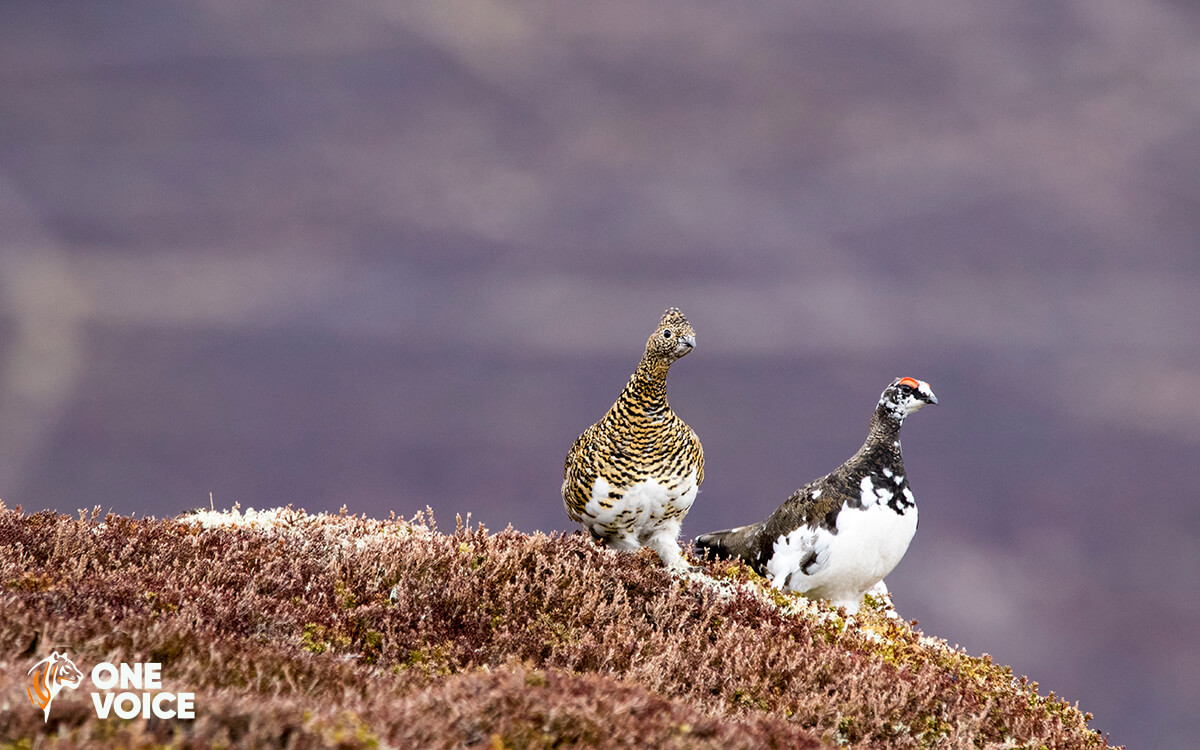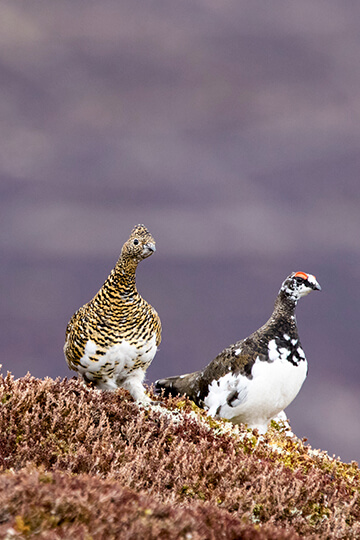

Mountain galliformes: understanding them to better protect them
Six species of galliformes still inhabit the summits of the French mountains. Extremely discreet and elusive, these birds are survivors from the Ice Age. Today, their ability to adapt is reaching its limits: forgotten by all, they are gradually dying out due to human pressure. We are fighting for them, before it is too late.
Cousins descended from the same ancient lineage, the Phasianidae, mountain galliformes have survived throughout the ages by braving the harsh cold and the test of time. They share common characteristics: a hardy biology, a round and stocky silhouette, short wings, sturdy legs made for walking or running rather than flying, and a camouflaged plumage that makes them almost invisible in their habitat. Yet each of the six species residing in our mountains also has its own distinct characteristics and its own unique way of approaching mountaineering. But regardless of their lifestyle and the altitude at which they live, all are now under threat.
Hazel grouse, ghosts of the damp forests
Altitude: 800 to 1600 m
Hazel grouse live in the quiet darkness of mixed forests. Virtually invisible, they never stray from their small territory, feeding on birch buds and hazel catkins. Like hushed shadows, they move silently and leave no trace. Unsuited to open landscapes, they particularly suffer from human activity and excessive logging.
Capercaillies, giants of clay
Altitude: 1,000 to 1,800 m
Massive and weighing up to four kilograms, capercaillies are the largest of the European galliformes. They depend on old, quiet, unfragmented forests. Every spring, they put on a striking display, folding their wings, puffing themselves up and snapping their beaks to impress their rivals. But their habitats are shrinking due to logging, human activity and global warming. They disappeared from the Alps in the 1990s. Only a few groups of individuals still survive in the Jura, Vosges and Pyrenees, besieged by roads, ski lifts and tourist activities.
Pyrenean grey partridges, resilient in the mountain pastures
Altitude: 1,200 to 2,200 m
With the transformation of the landscapes, they have only been able to survive in a few rare Pyrenean valleys where pastoral practices have remained gentle. Nesting at grass level, they depend on a mosaic of vegetation and non-intensive livestock farming to feed their young. But if pastoralism intensifies or disappears, the balance is upset: predators advance, shelters close up, eggs are trampled. They live in a narrow margin between too much neglect and too much pressure.
Black grouse, acrobats of the clearings
Altitude: 1200 to 2300 m
Every spring, between forests and mountain pastures, the males ritually parade in the clearings, puffing out their chests and spreading their lyre-shaped tails. In winter, they hide in the snow, digging an insulating burrow to conserve their energy. They are among the galliformes most threatened by human disturbance: cross-country skiing, snowshoeing, snowmobiles, noise, etc. Every time they flee to escape humans, they have to draw on their limited reserves.
Rock partridges, acrobats of the dry heights
Altitude: 1,500 to 2,800 m
The emblematic birds of the southern Alps, these partridges climb high to live among the rocks and ridges. Their striped plumage makes them almost invisible.
They feed on seeds, insects and roots. Running rather than flying, they dart between rocks as soon as anyone approaches. Like other mountain galliformes, they are paying a high price for increasing human activity and the encroachment on their habitats.
Rock ptarmigans, hermits of the peaks
Altitude: above 2,000 metres, sometimes up to 3,000 metres
At altitudes above 2,000 metres, among scree and sparse heathland, rock ptarmigans (or snow partridges) play at camouflage. Changing with the seasons, their brown spotted plumage in summer turns pure white in winter. They nest under rocks and feed on very little: lichens, seeds and buds. Faithful to their territory, they brave storms, hiding in rock crevices or under the snow. They are built for wind, cold and hostile environments. But not for helicopters or ever higher ski runs. Furthermore, during the breeding season, pastoralism poses a major threat to the survival of the broods.
On borrowed time
These birds, whose distant ancestors learned to cope with the climatic and geographical changes in their environment, now find themselves defenceless against human encroachment. So much so that the six species in our country are on borrowed time. Black grouse, rock ptarmigan, hazel grouse, Pyrenean grey partridge, rock partridge… all are ‘near threatened’ according to the IUCN. As for the capercaillies, their situation is even more critical, with numbers in constant decline: they are classified as ‘vulnerable’. Global warming is changing the seasons. Forestry and pastoral practices are altering their habitats. Ski resorts are encroaching on their territory. Chairlift cables are injuring them. Every escape costs them precious calories.
And yet… we hunt them
Despite this critical situation, scandalous prefectural decrees set the number of individuals to be “harvested” each year. Only capercaillies are theoretically spared due to their conservation status and the action of associations that obtained a five-year suspension of their killing from the Council of State in 2022. We continue to fight to prevent the relentless persecution they are facing, and to raise awareness of these birds, whose rituals and ancient memories have been passed down to us. The mountains can still echo with their songs. Provided we give them back the right to live.